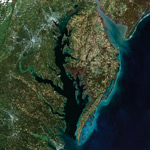
In August, the NOAA Center for Operational Oceanographic Products and Services (CO–OPS) released its enhanced suite of high tide flooding products including the 2023 Annual High Tide Flooding Outlook and the new Monthly High Tide Flooding Outlook.
Common in the Chesapeake Bay watershed, high tide flooding occurs when tides reach anywhere between 1 to 2 feet above the daily average high tide, depending on location, and cover typically dry coastal land. Impacts from high tide flooding can include temporary road and business closures and longer commute times.
As sea level rise continues, high tide flooding is occurring more frequently and it no longer takes severe weather to cause disruptive flooding along the coast. By 2050, high tide flooding on a national-scale is projected to occur between 45 to 85 days per year on average. Over time, recurrent high tide flooding events can have more severe impacts, like damaging above and below-ground infrastructure and degrading coastal wetlands.
2023 Annual High Tide Flooding Outlook
The Annual High Tide Flooding Outlook provides predictions of high tide flood days for the 2023 meteorological year (May 2023 to April 2024), at 98 NOAA tide gauge locations. These predictions are accompanied by a summary of high tide flood events from May 2022 to April 2023 and decadal projections out to 2050.
The 2023 Annual Outlook shows that last year, the U.S. experienced a national median of four high tide flood days, falling within last year’s prediction of three to seven days. This year, CO-OPS scientists predict that from May 2023 to April 2024 the U.S. will experience four to nine high tide flood days— about three times as many as typically occurred in 2000.
The expected strengthening of El Niño could further amplify high tide flooding frequencies along the East and West coasts for the remainder of this outlook year. Communities on the Mid-Atlantic and Gulf Coasts are expected to experience the most high tide flooding, as El Niño conditions will compound the effects of sea level rise in some areas.
New Monthly High Tide Flooding Outlook
The Monthly High Tide Flooding Outlook is intended to help communities better prepare for more frequent flooding in the near-term. This new digital product provides the likelihood of high tide flooding for each day in the calendar year, up to a year in advance, at NOAA tide gauge locations nationwide.
Together, the Annual and Monthly High Tide Flooding Outlooks provide high tide flooding information across timescales to help coastal communities prepare for potential flooding impacts in the near- and long-term.
Both outlooks are also integrated into CO-OPS’ Coastal Inundation Dashboard which provides real-time and 48-hour forecasts of water levels. This integration allows users to access tidally-driven flooding information in one location and provides for situational awareness about high tide flooding that worsen flooding impacts from other hazards, like coastal and tropical storms.
To learn more about high tide flooding, visit NOAA’s Regional High Tide Flooding Fact Sheets.
source: NOAA Center for Operational Oceanographic Products and Services
Leave a Reply
You must be logged in to post a comment.